More about Thimbles

Magdalena and William Isbister
Scythian tribes lived on the Northern Black Sea coast, including the Crimean peninsula, from the 7th century BC to the 2nd century AD (Fig 1). They relied on the subjugation of the agricultural populations in the region and the plundering and taxation of the neighbouring peoples for their livelihood. They captured and probably plundered Greek cities on the western Black Sea coast.

Fig 1
Chersonesus Taurica (Fig 2), in the south-western Crimea has been extensively excavated.

Fig 2
During one of the excavations of a Scythian settlement in the area, a thimble (Fig 3) in the same layer as silver coins, minted in Chersonesus in the 2nd century BC, was found (1). This must be the first thimble to have been found in Russia. It is similar in date to the first Chinese sewing ring found in a Han tomb and may have been of similar design to the Han thimble since thimbles may have travelled relatively quickly along the northern silk route to the region of Scythia.

Fig 3
Finding information relating to other Russian thimbles in general and early Russian thimbles in particular is not easy because of the paucity of information in the first place and secondly the difficulty of language and until recently the relative isolation of the country. Apart from papers by Holmes’ relating to the dating of Russian thimbles (2) and contemporary Russian thimbles (3), and a paper by Pelham Burn concerning steel topped thimbles (4), little has been written about the thimbles of Russia. Russian fake enamel thimbles are mentioned by Holmes in his ‘dating’ paper (5). The only other source of information concerning early Russian thimbles that we have been able to identify is the website of Irina Sotnikova (http://www.thimble.h11.ru/index.html) and the comprehensive writings of V N Klechinov on that site and at: http://thimbles.ru/index.php.
In ancient Russian, thimbles were called ‘kistenki’. A type of thimble was used to weight the fingers for fist Fighting in Russia and thimbles were also worn on the right thumb by archers (6).
In this paper we will try to put together, in chronological order, the information that we have been able to obtain concerning Russian metal thimbles. We will limit discussion of modern Russian thimbles because they are extensively addressed by Sotnikova (7).
Archaeological thimbles
There seem to have been three distinct sets of thimbles found during archaeological excavations in Russia. Those found in other parts of Europe and thus most probably made in Nürnberg during the Middle Ages, those made later in Holland and those that are not found elsewhere in the world and thus most probably of Russian origin. It is suggested that some thimbles evolved from thimbles brought to the region by the Mongolian Armies as they moved west along what became known as the northern part of the ‘Silk road’. These thimbles thus have a similarity to other eastern Mediterranean thimbles.
In Kama, in the region of Perm, an open topped, cast, hand dimpled thimble (Fig 4) was found (8). It was thought to date from the 11th or 12th century and is similar to early Chinese sewing rings.

Fig 4
In the same region sewing rings (Fig 5) have been found which date to the 13th century and have a needle pushing area similar to another ‘needle pusher found along the ‘Silk road’ in Mongolia (Fig 6).


Fig 5 Fig 6
In 2001, Moscow archaeologists excavated a monastery site close to Moscow (9). There was no above ground evidence of the monastery left at the time of the excavation but amongst many craft and household items found there were two thimbles (Fig 7). One was a simple seamed sewing ring and was dimpled by hand; the other was a short thimble with vertical hand dimpling and a small opening in the top. The thimbles were probably made in Nürnberg in the 14th or 15th century.

Fig 7
In the past it was the custom to bury women with their thimbles and sewing tools so that early thimbles are often found in association with female burials. In a 14th - 15th century woman’s burial site close to Perm, jewellery, a coin dated to the mid 14th century and a thimble were discovered. The thimble was conical in shape with an open top and hand indentations. It was made out of a copper alloy sheet and after fashioning into a cylinder the seam had been soldered with lead (Fig 8). A similar thimble was discovered in Astrakhan further to the South-West of Perm. Pelham Burn and the Dutch Thimble Club (10, 11), however, think that this type of thimble (Fig 9) was made in Nürnberg in the 15th or 16th century.


Fig 8 Fig 9
Another 14th century thimble was found in Novgorod which is one of the most ancient towns in Russia. The town was mentioned in chronicles in 859. The thimble is on view in the Museum of History of Novgorod (Fig 10). The thimble is made of latten (a brass like alloy commonly made in thin sheets) and has a small hole in the top. It is a shorter version of the Perm thimble and was probably made in Nürnberg too.

Fig 10
In the Middle Volga region, topless thimbles have been found which were initially made from a sheet of copper alloy which was curled into a cylinder and then soldered. The indentations were made by hand in anticlockwise spirals above a thickened rim (Fig 11).

Fig 11

Fig 12
Later the thimbles were cast in a flat brass sheet and then curved to a cylinder (Fig 12). The indentations were made in the casting process and the thimbles were rather crudely made (Fig 13).

Fig 13
Some thimbles seem to have been left un-soldered All of these thimbles probably date to the 14th century.

Fig 14
Later thimbles lacked a seam and were dimpled by machine (Fig 14). These thimbles date to the 18th century.
Thimbles with tops which are rather similar to those made in Holland in the 18th century have also been found in this region (Fig 15). They may have been imported.

Fig 15
A variant of these cast machine dimpled thimbles has, instead of a ‘waffle dimpled top, a ‘spiral’ dimpled top (Fig 16). This type of top has only been seen in Russian thimbles.

Fig 16
In the region of Krasnodar, there is a brass thimble in the Anapa Museum. The thimble probably dates to the 16th century, is made in one piece and has a plain top decorated with four circles (Fig 17). The dimpling has been made by hand.

Fig 17
Other thimbles found in this region (Kuban) are very similar to those thought to have been made in Nürnberg in the 16 and 17th century too (Fig 18).

Fig 18
The thimbles are deep drawn, have hand dimpling and smooth decorated tops.
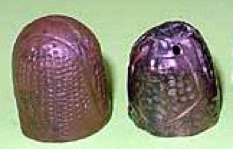
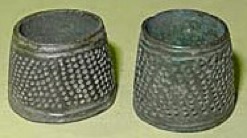
Fig 19
Hama (12) thimbles (left) and Byzantine thimbles (right) have also been found in this region (Fig 19). There was a brisk trade across the Black Sea from what was then Byzantium (Istanbul) and the Krasnodar region and it is possible that the thimbles reached the region by this route.
A Dutch merchant, A D Vinius, was granted royal approval to build a metallurgical plant near to the town of Tula in 1632 (7). Excavation of the site in 1991 led to the discovery of four plants. Material found on the site included military and civilian items including a single bronze thimble and Dutch clay pipes. Whether this thimble was made on site or imported along with the pipes is not clear from the excavation.
Twenty-two charred thimbles were found in an excavated fort that had burned down in Ishim in the Omsk region of Russia. A cast two part thimble, thought to be of Russian origin (13) had a mechanically dimpled waffle top and an anticlockwise spiral of hand dimples (Fig 20). This combination of mechanical and hand dimpling is very unusual. This thimble may have been made in the 16th century.

Fig 20
Several thimbles were mechanically dimpled, had waffle tops (Fig 21) and some had rims (Fig 22). These could easily have been imported from Holland in the 17th century.

Fig 21

Fig 22
Another type of thimble found in the remains of the fortress was deep drawn, had a flat top with very coarse waffle dimpling and was mechanically dimpled (Fig 23). This type of thimble has not been seen elsewhere and so may be a unique Russian design.

Fig 23
One two-part thimble was mechanically dimpled but the top was plain with two concentric rings and a dot in the centre (Fig 24). This may also be a Russian made thimble.

Fig 24
The Ishim thimbles were found with 18th century coins and it is supposed that the fire must have taken place at around this time. The thimbles must thus have all been made earlier than the fire and some considerably earlier in the 17th century. Klechinov (13) thinks that all of the Omsk thimbles were made in Russia because even the ‘Dutch’ ones seemed to be less well made than thimbles really made in Holland. Sometimes locally made thimbles appeared with very small or absent indentations. We think that it is not so easy to differentiate manufacturing defects from damage caused by fire and lying buried for centuries and feel that the ‘Dutch-type’ thimbles were, in fact, probably imported. There seems to have been, after all, a thriving import trade with regard to thimbles in Russia from Byzantium, Nürnberg, and Holland.
A type of thimble that has been found in the ground in many Western (European) parts of Russia seems to be unique to Russia and it is deduced that the thimbles must be of Russian origin. They are ‘tailor’s’, open topped thimbles with a copper alloy inside and an iron ‘sleeve’ outside (Fig 25). They are machine dimpled and sometimes the dimpling may extend through the iron cladding to the copper alloy thimble (Fig 26).


Fig 25 Fig 26
Most times the iron is corroded and sometimes the corroded iron has been completely removed to allow the remaining copper alloy structure to be further used for needle pushing (Fig 27).

Fig 27
It is thought that these thimbles were made between the 17th and 19th century. A similarly constructed type of thimble was made in England in the 19th and 20th century (Fig 28).

Fig 28
More Nürnberg thimbles (Fig 29) (with makers marks) from the middle Ages have been found in the Ukraine region and it seems that these are further evidence for the brisk trade with the West at this time. In the Russian literature these thimbles have been said to originate in Byzantium but in reality this important town may simply have been a port in their long journey across Europe.
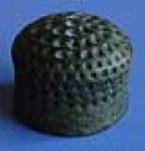
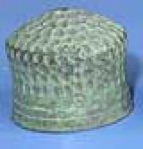
Fig 29
One other type of thimble, made in the 18th century and found in the Volgograd region seems to be unique to Russia. This type of thimble has a hand-dimpled top but the sides are dimpled by machine (Fig 30).

Fig 30
Serpukhov was a busy industrial centre, south east of Moscow, in the 16th, 17th and 18th century. Iron ore was mined locally and along with the mining and smelting of the metal, the blacksmith’s trade flourished. In the late 17th and 18th century many blacksmiths were forced to move south to work in Kiev and the Caucasus. Bronze thimbles from the 18th century have been found along a river bank (Fig 31), in excellent condition, about 15 miles from the iron town. These thimbles have also been found in the Omsk region. It is possible that the thimbles were made in Serpukhov and spread from this iron-working town with the blacksmiths and their families who travelled eastwards and southwards in the 17th and 18th century explaining their appearances in Omsk and the Middle Volga regions.

Fig 31
One of the thimbles had a ‘spiral’ top and was very similar to the one previously described (Fig 16) from the Middle Volga region.
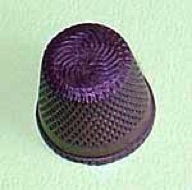
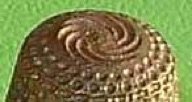
Fig 32
These thimbles (Fig 32) do not seem to be found far outside of the central region of Russia. They seem to date from about the mid 17th century and their production continued well into the 19th century (14). The early thimbles lack a rim and were made in two parts (Figs 33, 34), later they were cast with a plain band above and below the dimpling (Fig 35), then a plain band below the dimpling only (Fig 36), then with a rim and rhombic side indentations (Fig 37) and finally with a rim and round indentations (Fig 38). They were all machine dimpled.



Fig 33 Fig 34 Fig 35

Fig 36


Fig 37 Fig 38
Thimble writings
The first written account of thimbles in the Russia literature dates to 1669 (6). In the account book of the Iversky Valdai Monastery an entry indicates that the Monastery obtained 40 thimbles and 300 sewing needles. The Iversky Monastery is located on one of the islands of the Valdai Lake to the North West of Moscow. It was built under the auspices of Patriarch Nikon in the 17th century. It seems probable that these thimbles were imported from Germany or Holland.
In 1704, the word "thimble" was first included in Fedor Polikarpov’s Trilingual Lexicon. A few years later, thimbles were amongst the items sold by the St. Petersburg merchant, Andreas Sendler (6). It appears that they were made from tombac (an alloy of copper and zinc) and in 1775 they cost four pennies each (6). Thimbles soon become fashionable amongst the aristocracy and were included along with scissors and needle cases in the contents of purse-like ‘chatelaines’, which were made in precious metals and which decorated their ball gowns. (6). Similar less expensive ‘chatelaines’ were carried by many women in Russia. They were usually made of locally obtained materials and contained various needlework items including thimbles. As in other countries (15) thimbles were used in Russia to decorate clothing in days gone bye.
By the beginning of the 19th century thimbles were widely available in Russia including the monasteries and the Tsar's workshops. Thimble making was established in the towns of Velikiy Ustyug, Saint Petersburg, Moscow and Vladikavkaz (16).
Six Russian thimbles were exhibited at the Kazan Handicraft Exhibition in 1890. According to the exhibition catalogue, the thimbles cost 80 cents each, and were made in the ‘Caucasian style’. Thimbles in the ‘Caucasian style’ were produced in St. Petersburg and often bore the word ‘Caucasus’, in Cyrillic on the border.
Pre-revolutionary designs were often used, especially early on, in Soviet times.
Some commemorative thimbles were made prior to the Russian Revolution but advertising thimbles were very rare indeed (6). Many of the Great Museums of Russia do have thimbles in their collections but they are rarely seen by the general public.
Modern thimbles
The scarcity of surviving Russian thimbles, the relative isolation of the country for so long and the relatively limited production of thimbles in Russia make obtaining Russian thimbles a difficult task for a collector. With the advent of the fall of communism, some thimbles did come out of Russia and then when dealers saw the high prices that could be obtained for some types of Russian thimbles, there was a flood of ‘fake enamel’ and ‘Fabergé type’ thimbles in the antique arena (17).
Marks on Russian silver and gold
Russian silver and gold thimbles may have no marks, a single mark or several marks. These marks include a makers mark, a mark from the assay office and the mark of the assay master, the town mark, a number which signifies the fineness of the metal and more recently a date code. Until 1923 the fineness was measured in zolotniks (1/96th of the Russian pound of 409.5174 grammes). Pure silver or gold contained 96 zolotniks, the silver used in thimbles was usually 84 zolotniks, 14 karat gold was 56 zolotniks, 18 karat gold was 72 zolotniks and 22 karat gold was 88 zolotniks. In 1896 a national mark (kokoshnik) was introduced by Tsar Nicholas ll. The kokoshnik is a traditional Russian headdress that was worn by women. It was tied at the back of the head with long thick ribbons and in the late 19th century, became part of official court dress. Pre-revolution thimbles were thus stamped with either a woman’s head facing left wearing the headdress (first kokoshnik – 1896 -1908) or an uncovered woman’s head facing right (second kokoshnik – 1908 -1917). The assay master put his mark next to the woman’s head in the first kokoshnik mark but only the code (a Greek letter) for the assay office in the second kokoshnik. After the Revolution, fineness was measured using a decimal system but it seems that little silver or gold was worked between 1917 and 1927. Later thimbles bore a workman’s head above a hammer (1927-1958) or a hammer and sickle in a five-pointed star (post 1958) and the mark of the assay office. There are several shapes of national mark but the commonest seen on thimbles are either oval or a spade shaped. The kokoshnik mark (1908-1926 version (Fig 40)) was reinstated in 1985 and this may easily be confused with the original second kokoshnik mark. This may make the dating of Russian thimbles more difficult in the future. In an attempt to correct this problem the kokoshnik mark was slightly modified so that it now has a rounder contour than the pre-revolutionary mark.
The Saint Petersburg’s ‘sceptre and two crossed anchors’ and Moscow’s ‘St George on horseback killing the dragon’ marks are the town marks most commonly seen on thimbles.
Fineness mark






Fig 39 Fig 40 Fig 41


Fig 42
Fig 39. A silver mark, 84 zolotniks, left facing woman’s head, assay master’s mark (AB, possibly Alexander Virjohovsky) for 1896 – 1908. The photograph is of a similar mark but the assay master’s mark is AP (A Romanov).
Fig 40. A gold mark, 56 (14 karat), woman’s head facing right, Moscow assay office mark (Δ) for 1908 – 1917. The photograph is of a similar mark but for silver.
Fig 41. A silver mark (875), post-revolution worker’s head above hammer, Moscow assay office mark (Δ), for 1927 – 1958. The photograph is of a similar mark but for 916 silver and has a Leningrad assay office mark (α).
Fig 42. A silver mark (875), hammer and sickle inside a five-pointed star, after 1958. The photograph is of a similar mark but has an unclear assay office mark (r).
Town mark


Fig 43 Fig 44
Fig 43. The Saint Petersburg town mark.
Fig 44. The Moscow town mark.
Maker’s mark
Kф M·п
Fig 45 Fig 46
Fig 45. The maker’s mark of Karl Fabergé.
Fig 46. The maker’s mark of Karl Fabergé’s workmaster, Michael Perchin.
Most other maker’s marks seen on thimbles are not known.
Maker’s mark and date code

Fig 47
The Leningradskaya Yuvelirnaya Fabrika (Leningrad District Jewellery Factory), in addition to the factory mark (LF), used a date code (‘6’) to signify that the thimble was made in 1956 (Fig 47). The date code seems to indicate the last digit of the year in which the thimble was made
Imported thimbles often bear a Russian mark so the marking cannot be used solely to determine the country of manufacture. Sometimes thimbles may have two marks, one for the country in which the thimble was made and the other a Russian mark indicating that the thimble was sold in Russia. Russian marks are usually stamped on the rim and are often difficult to read.
Enamel
Russian enamel thimbles are made by soldering a thin filigree wire to the thimble border in order to make complex patterns. The shapes so produced are then filled with coloured enamels and baked. A thimble with many coloured panels would require many backings.
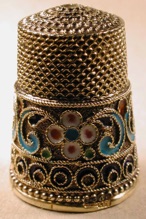
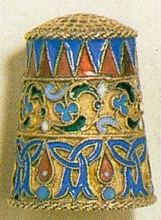
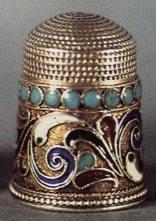
©Christie's ©Christie's
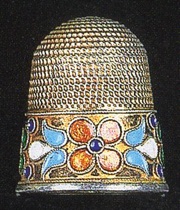
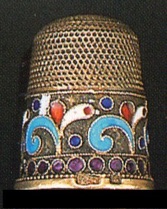
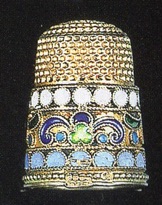
©Christie's ©Christie's ©Christie's
Fig 48
Early cloisonné enamel thimbles (Fig 48) were usually taller than later ones (Figs 49-52), the filigree wire was finer and their patterns were more complex. It seems most likely that these thimbles were made in the Saint Petersburg area. The thimbles shown were all made prior to the Revolution in 1917 and bear a second kokoshnik mark and 84. Some have maker’s marks but they are unknown.



Fig 49 Fig 50 Fig 51

Fig 52
The thimbles in Figures 49 and 50 were made in the Leningradskaya Yuvelirnaya Fabrika. The town name in Cyrillic translates to Kiev and this thimble was made in 1956 according to the maker’s mark and date code (ЛФ 6). It is further marked with a worker’s head over a hammer, 916, and the Leningrad assay office mark. The other thimble made by the Leningradskaya Yuvelirnaya Fabrika (Fig 50) has a 1959 maker’s mark and date code (ЛФ 9), a hammer and sickle within a five-pointed star, 916, and the Leningrad assay office mark. The third thimble, silver-gilt (Fig 51) was made in the 60’s, by Alfa (18), has an unknown assay office mark (^), a hammer and sickle within a five pointed star, 925, and a maker’s and date code (: 8ЛС). The last thimble (Fig 52) was made by Russkiye Samotsvety, Saint Petersburg in 2002. The Factory was established by Czar Peter l in 1721 and was later the site of the jewellery firm of Carl Fabergé (Fabergé's school). The thimble is marked 925 and is part of an etui (Fig 53).

Fig 53
Sadly these enamel filigree thimbles have been replicated, often rather crudely and sold for high sums of money. Just one example (Fig 54) will suffice to show the casting marks running down the dimpled portion of the thimble indicating that it is not made in the proper way with filigree wire. It bears a makers mark on the rim (Ф.P. for Fedor Rückert). Fedor Rückert was a Fabergé workmaster in Moscow and clearly he never made this thimble!
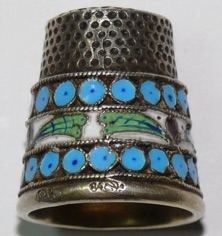
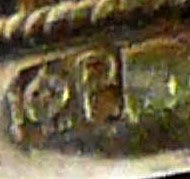
Fig 54
Gold
Most Russian gold thimbles are made out of 14 karat gold and have the fineness mark of 56 with the town mark (Fig 55). The marking is often very indistinct because the punches are bigger than the rim of the thimble so not all of the mark may be seen, and the mark may be badly rubbed. We have not been able to identify a date mark on a Russian gold thimble.

Fig 55

Fig 56
This early 19th century thimble (Fig 56) was made by Victor Finnikov (B.Ф) in Saint Petersburg. It is without additional decoration and dimpled down to the plain flat rim.
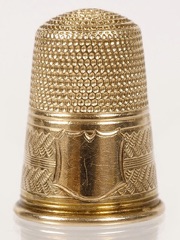
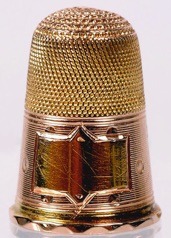
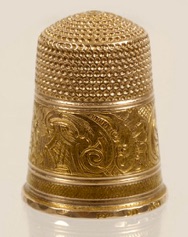
Fig 57
These thimbles (Fig 57) were all made in the 19th century. The thimble on the left has bands of engine turned wave patterns and an empty shield shaped cartouche. It is marked Ф.K (FK), possibly Freidrich Koechli of Saint Petersburg. The middle thimble is made of two-colour gold decorated with engine turned lines upon which round disks have been engraved. The rim is faceted and the cartouche is empty. The maker is unknown but the thimble was made in Saint Petersburg. The right thimble has an engraved scrolling floral pattern above a plain band. The marks are impossible to decipher.


Fig 58 Fig 59
Waffle tops seem to have been common on early Russian thimbles and this 19th century steel topped gold thimble (Fig 58) has a waffle top. The border is decorated with an engraved floral pattern. It is not possible to make out the marks on the rim of the thimble.
Karl Bock (КБ) was an Imperial Court Jeweller in the early 20th century. He had shops in Saint Petersburg and Moscow and made this gold thimble (Fig 59). It is a simple gold thimble with three pear shaped natural rubies set into a special applied floral decoration. It is marked with the maker’s mark (КБ) (Fig 60), a woman’s head facing left, 56 and AP (AR) for the assay master Alexander Romanov of St. Petersburg, 1899-1908 (Fig 61).

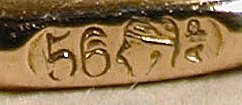
Fig 60 Fig 61
Fabergé
There has been quite a lot of controversy regarding whether Carl Fabergé ever made thimbles (17). There can be no doubt, now, that some of the Fabergé workmasters did, in fact, make thimbles although there are not many known examples. For completeness, three examples of what are thought to be Fabergé thimbles are illustrated in this paper. One (Fig 62) is similar in style to the Bock thimble already described (Fig 59). The thimble has plain sides with an applied two colour gold flower with three ruby and two diamond petals and a single diamond central stone. A Cyrillic monogram, ВБ (WB), is engraved on the opposite side of the thimble. The rim is marked 56 and Kф (KF), the Fabergé mark for small objects.



Fig 62 Fig 63 Fig 64
© Rund um den Fingerhut
A Fabergé thimble (Fig 63) by Michael Perchin is thought to have been made around 1890 and has the workmasters mark (М.Π), ‘Fabergé’ in Cyrillic, the town mark for St. Petersburg and 56 for the gold fineness in the top of the thimble. The inventory number (51660) is scratched inside the rim. The third example (Fig 64), also in a private collection, is a gold child’s thimble that is decorated above the rim in a Greek key design in turquoise champlevé enamel. The marks are unclear but it was supposedly made by Fedor Afanassiev who was also a Fabergé workmaster.
Metal
Simple brass or tinned iron thimbles (Fig 65) abounded during the Soviet era. They were quite unremarkable and as recently as the late 90s were the only thimbles available at GUM (State Department Store) in Moscow.

Fig 65
After the fall of communism in Russia some enthusiastic entrepreneurs took some of the plain Soviet thimbles and decorated them with button tops or beads to make them more attractive to visitors, who by this time, were beginning to appear in antique shops asking for old thimbles (Fig 66).
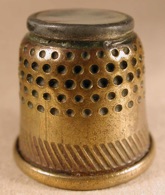
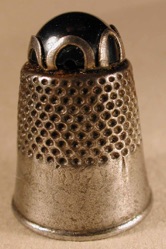
Fig 66
Niello
Niello is a black mixture of copper, lead and silver sulphides and is used for filling in designs in engraved or etched silver or other metal, prior to baking, in order to enhance the design. It is thought that the Egyptians were the first to use the technique, and in the Iron Age, the method soon spread all over Europe. From the 13th to the 15th century the technique of niello decoration was well established in Russia, in particular in Kievan Rus (now the Ukraine) and Velikiy Ustyug, a town about 1000 km. North East of Moscow. Niello thimbles seem also to have been produced in Kostroma and assayed in Saint Petersburg. The Ukrainian thimbles had Kiev town marks and tended to be less well made and lighter and so less expensive than the niello thimbles made in Kubachi, Dagestan (19). The niello technique is still in use today for decorating thimbles.



Fig 67 Fig 68 Fig 69
Many Niello thimbles were made as souvenir thimbles and the commonest marking ‘КавказЪ’ translates to Caucasus (Figs 67 – 69). The left thimble has a plain dimpled top in contrast to the other two thimbles which have waffle indentations. The left two thimbles have Saint Petersburg marks and 84 (Figs 67, 68). The right thimble has 84 and an unreadable town mark. All three thimbles were made in the 19th century before the introduction of the kokoshnik mark (i.e. before 1896). One thimble has a clear maker’s mark AП but the maker is unknown.



Fig 70 Fig 71 Fig 72
These three thimbles were made after the Russian Revolution; the left two thimbles (Figs 70, 71) bear workers head marks and 875. A maker’s mark ЖА (HA) belonging to an unknown maker is seen on the left thimble, but there is no maker’s mark on the next thimble but it does have an Odessa assay office mark. All three thimbles are decorated with a floral niello pattern; the right thimble (Fig 72) is gilded above and below the niello. It has a hammer and sickle mark, 925 and a maker’s mark and date code (:9ACЧ). It was made in 1969 by Severnaja Cherny (Northern Niello – literally ‘Northern Black’) in Velikiy Ustyug in the Vologda region. The factory was established in 1933 but Velikiy Ustyug has been the home of silversmiths using niello decoration since the 17th century. Michael Koshkov was one of the most famous niello silversmiths in Velikiy Ustyug in the 19th century (20). The niello from Velikiy Ustyug differs from other silver niello work in that the niello is brushed on to the flat silver instead of being put into a previously made engraved pattern.

Fig 73
Niello thimbles attached to rings are not commonly seen (Fig 73). The combination is more commonly seen with thimbles made in the Middle East, but this thimble and ring set is marked with the Novotcherkask town mark, a town in the South of Russia close to the Ukrainian border and possibly at one time on the Northern Silk route which may have passed between the Black and Caspian seas. In addition to the town mark is an unknown maker’s mark MV and 84. The thimble was made some time before 1896.
Niello Cartridge cap thimbles
Some niello ‘thimbles’ (Fig 74) which resemble the caps used by Cossack soldiers to close their cartridge containers (Fig 75) have been used by women in the Ukraine for sewing. The sides and top are covered with fine indentations that would allow a firm grip for a needle. They seem to be shorter than the cartridge caps (21), are not smooth and do not have any protrusions. We have been told by a lady from the Caucasus that, whatever the original intention of these objects, many were, in fact, used as thimbles by Caucasian women in the last century.


Fig 74 Fig 75

Fig 76
Some ‘cartridge cap’ thimbles had waffle tops and clearly they were made for sewing (Fig 76).
Silver
It has been difficult to find pre-revolution Russian silver thimbles. Some were made in Russia and others were imported from Germany and probably other European countries prior to Soviet times.
The earliest Russian silver thimble that we have been able to identify (Fig 77) was made in Moscow and assayed in 1820. The top and sides are ‘square’ dimpled above a plain border with double rope bands. It is marked with the Moscow ‘St. George killing the dragon’ above ‘1820’ and ‘84’ (Fig 78).


Fig 77 Fig 78



Fig 79 Fig 80 Fig 81
Pelham-Burn (5) has identified a type of Russian steel topped thimble that has a very simple plain design and often a faceted rim (Fig 79). The thimble is marked with 84; a maker’s mark which looks like AK (possibly Alexander Karpov, Saint Petersburg, or Antip Kuzmichov, Moscow) and an unknown town mark. The thimble must have been made before 1896. The middle thimble (Fig 80) has a backed stone top, an engraved floral design and a plain rim. It is marked 84 with a right facing kokoshnik and may not have been originally made in Russia. The thimble on the right has a backed silver top, an engraved floral design and a round rim (Fig 81) It is marked in the same way as the middle thimble and, it too, was probably imported into Russia, possibly from Estonia, Finland or other Scandinavian country.


Fig 82 Fig 83
These typical Soviet era thimbles have round dimpled tops and rhomboid dimpling on the sides, plain borders and turnover rims. The first thimble (Fig 82) has a workers head above a hammer, ά – the Leningrad assay office mark, 875, and an unknown maker’s mark (ЛЮ). It must have been made between 1927 and 1958 in the jewellery factory in Leningrad. The second thimble (Fig 83), made somewhat later in Tbilisi, Georgia, has a hammer and sickle contained within a five-pointed star, an r (unknown town mark), 875, and an unknown maker’s mark and date code (TЮ 9). Possibly made in the Tbilisi Jewellery Factory. It should be noted that the Leningrad marks are placed vertically and the thimble rims are heavily decorated.


Fig 84 Fig 85

Fig 86
Both of these thimbles (Figs 84, 85) were probably made in Germany and imported into Russia prior to the Revolution. Both have backed stone tops but the second thimble (Fig 85) has clearly had the original top replaced. It is a souvenir thimble for Yalta, the name being written in Cyrillic around the border. The left thimble has a single ‘84’ marking, but the right thimble has 84, a right facing kokoshnik import mark (Fig 86) and an assay town mark for Odessa (x).
Conclusion
The earliest thimbles found in Russia seemed to have been imported but soon Russian thimble makers did embark upon the production of thimbles that have designs unique to Russia (spiral indentations on top, and rhombic dimpling). As thimble making became more sophisticated these designs or methods of manufacture were retained so that even during the Soviet era such thimbles may be found. Prior to the Revolution, thimbles continued to be imported from Europe but more recently most modern thimbles now seem to be made, primarily as souvenirs, in Russia itself. Carl Fabergé and some of his workmasters did make thimbles in Imperial Russia.
Acknowledgements
We would especially like to thank Mrs Irina Sotnikova from whose web site much of the archaeological information was obtained and who freely allowed us to use her images.
Thanks too to Mr John Atzbach who allowed us to reproduce thimbles from his collection.
We thank Mr Jeremy Rex-Parkes for permission to use Christie’s auction images.
References
1.Kleshchinov VN. Scythian thimble. http://thimbles.ru/page.php?51
2.Holmes EF. The Dating of Russian Thimbles. Thimble Notes and Queries 1991; 12: 2.
3.Holmes EF. Contemporary Russian Thimbles. Thimble Notes and Queries 1992; 14: 2.
4.Burn DP. New Discovery in steel-topped thimbles. Thimble Notes and Queries 1991; 11: 2.
5.Holmes EF. The Dating of Russian Thimbles. Thimble Notes and Queries 1991; 12: 6
6.Сосна AE. У всякой пташки свои замашки. Родина", 1996; 4
7.Irina Sotnikov. Russian Thimbles. (http://www.thimble.h11.ru/index.html )
8.Kleshchinov VN. Thimbles of Finno-Ugric tribes. http://www.thimble.h11.ru/stat11.html
9.Arsyuhn E. Exploration in Moscow Region. 2002. http://archeologia.narod.ru/derev.htm
10. Burn DP. Early Thimbles. Thimble Collectors International, 2001. pp. 42.
11. Dutch Thimble Club. Excavated Thimbles. TSL Magazine 1995; 5 (6): 4.
12. Plough G, et al. Hama, Fouilles et Recherches 1931- 1938 lV3. Copenhagen: Fondation Carlsberg, 1969. pp. 86.
13. Kleshchinov VN. Thimbles from the Siberian jail. http://www.thimble.h11.ru/stat18.html
14. Kleshchinov VN. Russian thimble with an unusual peak. http://www.thimble.h11.ru/stat21.html
15. Isbister M, Isbister W. Collecting thimbles in the Kingdom of Saudi Arabia. TCI Bulletin 2004; Spring: 1.
16. Irina Sotnikov. Russian Thimbles – Crafts - Northern Niello. http://www.thimble.h11.ru/prom.html#metk1
17. Isbister M, Isbister W. Fabergé Thimbles. TCI Bulletin 2009; Summer: 1.
18. Irina Sotnikov. Russian Thimbles – Present times. http://thimble.ru/moder.html
19. Kleshchinov VN. On Kubachi thimbles. http://thimbles.ru/page.php?39
20. Predein H. Russian thimbles. TSL Magazine 1996; 5: 11.
21. McConnel B. The story of the thimble. Atglen, PA.: Schiffer Publishing Ltd, 1997. pp. 126.
Holmes: 'Enamel Thimbles' pp. 84, 'Silver Thimbles' pp. 101, Souvenir Thimbles' pp. 183.
Researched and published in 2002/11
Copyright@2011. All Rights Reserved
Magdalena and William Isbister, Moosbach, Germany
Addendum 1/2015
Recent information concerning the Scythian thimble would suggest that the dating of the thimble may not be too robust and that it may, in fact, date to a considerably later period (600-800 AD). Several other similar thimbles or parts of thimbles seem to have been discovered in the Eastern Mediterranean from the same period although the literature relating to these thimbles is not available to us, and some are unpublished. They may have been made in China and exported with the silk and steel needles.

A history of Russian Metal thimbles



Navigation
